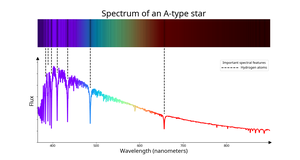Glossarbegriffe: A-Stern
Description: Ein Stern mit der Spektralklasse "A". Astronomen erkennen A-Sterne daran, dass ihre Spektren starke Absorptionslinien von Wasserstoff aufweisen. Sie haben typische (effektive) Temperaturen zwischen etwa 7400 Kelvin (K) und 10.000 K. Im Vergleich zu anderen Sternen erscheinen sie dem menschlichen Auge weiß oder bläulich weiß, außer Extinktionseffekte (entweder durch die Erdatmosphäre oder durch das interstellare Medium) spielen eine Rolle. Beispiele für Sterne der Spektralklasse A sind Sirius, der hellste Stern am Nachthimmel, im Sternbild Großer Hund, sowie Wega im Sternbild Leider.
Zugehörige Glossarbegriffe:
See this term in other languages
Term and definition status: The original definition of this term in English have been approved by a research astronomer and a teacher The translation of this term and its definition is still awaiting approval
The OAE Multilingual Glossary is a project of the IAU Office of Astronomy for Education (OAE) in collaboration with the IAU Office of Astronomy Outreach (OAO). The terms and definitions were chosen, written and reviewed by a collective effort from the OAE, the OAE Centers and Nodes, the OAE National Astronomy Education Coordinators (NAECs) and other volunteers. You can find a full list of credits here. All glossary terms and their definitions are released under a Creative Commons CC BY-4.0 license and should be credited to "IAU OAE".
If you notice a factual or translation error in this glossary term or definition then please get in touch.
Related Diagrams
Spectrum of an A-type star
Bildnachweis: IAU OAE/SDSS/Niall Deacon
License: CC-BY-4.0 Creative Commons Namensnennung 4.0 International (CC BY 4.0) icons









